CO₂ Control for Dynamic Cell Culture
CO₂ sensing and control independent of a CO₂ incubator
Be independent of the CO₂ Incubator
Control CO₂ of the media on the bench
Use the chip of your preference
Inline sensor can be added to any setup
Automated cell culture
Less manual work and more accuracy for your experiments
Plug-and-play platform
Beginner friendly pack with detailed user guide
The importance of CO₂ control for cell culture
The human body maintains its pH through a buffering system based on bicarbonate and CO2. In other words, CO2, usually produced as waste from metabolism, reacts with H2O to form carbonic acid, a weak acid. This reaction creates a dynamic equilibrium that shifts depending on the concentration of H+ to maintain the overall concentration of ions constant, as shown below. The amount of CO2 and carbonate available to buffer the system is regulated by the lungs and kidneys according to the body’s needs.
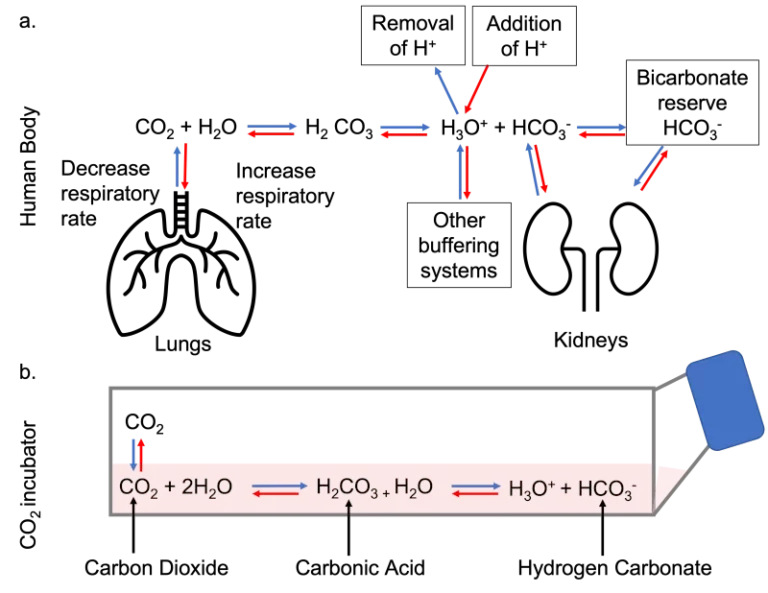
In cell culture, the same principle is applied. Media usually contains a predefined concentration of carbonate and the CO2 incubator maintains the internal atmosphere with a determined concentration of CO2, so the same dynamic equilibrium is formed.
However, there is no automatic way to adjust the concentrations of the buffering components as the body does with the lungs and the kidney, so the cell culture media needs to be changed regularly to keep the pH within adequate ranges.
The importance of CO₂ control in dynamic cell culture
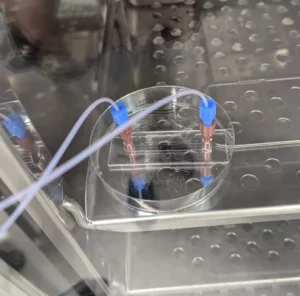
In dynamic cell cultures, that is, when cells are cultured under flow, the microenvironment parameters become more important to control because the system’s small dimensions make small changes in pH more impactful.
Thus, either the entire perfusion system is designed to fit inside the CO2 incubator, or parts of the system (mainly the electronics) remain outside, and the chip with the cells is kept inside the incubator in a far-from-ideal configuration.
CO2 control in dynamic cell culture pack setup
Our all-in-one pack guarantees good compatibility between the different instruments, allows you to start your experiment right away, is piloted by a single software, and can be used for other applications. We also provide continuous and full customer support for you to fulfill your experiment goals.
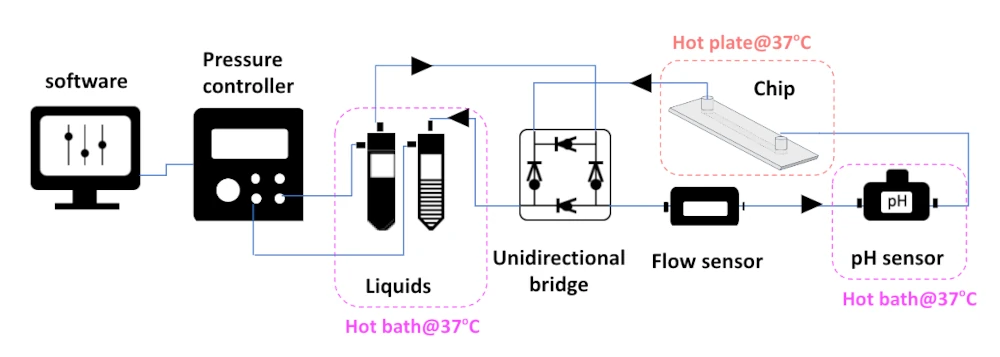
The pack contains:
Flow sensor (Galileo, MIC)
Software (Galileo user interface)
A pH/CO2 sensor and flow cell for use in line in setup
Pressure controller
Several Eppendorfs or Falcon reservoirs
Recirculation bridge
Microfluidic chips
Tubing and luers
User guide
This pack can also be combined with other microfluidic steps following the dynamic cell culture, such as sequential drug injection.
Behavior of CO2 in cell culture media
Culturing cells inside a CO2 incubator set at 5% has become such a standard practice in biology labs. A report from Klein et al. [1], analyzing 810 papers, clearly illustrates this. Most cell culture parameters, such as temperature, CO2 and O2 concentration and pH, are often described but rarely characterized or measured during experiments.
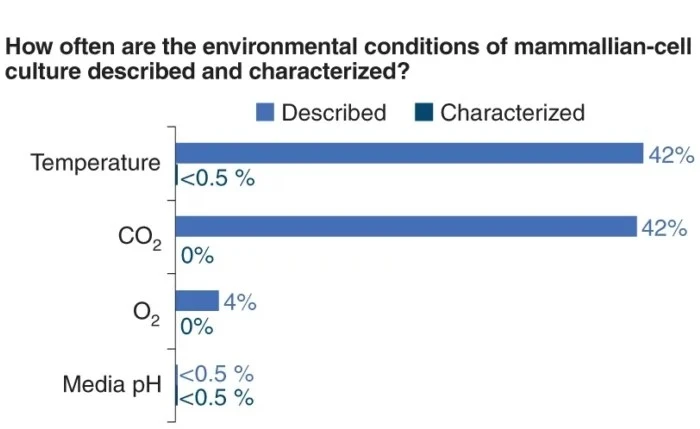
Consequently, few realize that different cell culture media require different CO2 levels to maintain the pH within acceptable ranges, as illustrated below. DMEM, for example, has 44 mM of NaHCO3, requiring a higher concentration of CO2 to achieve physiological pH [2].
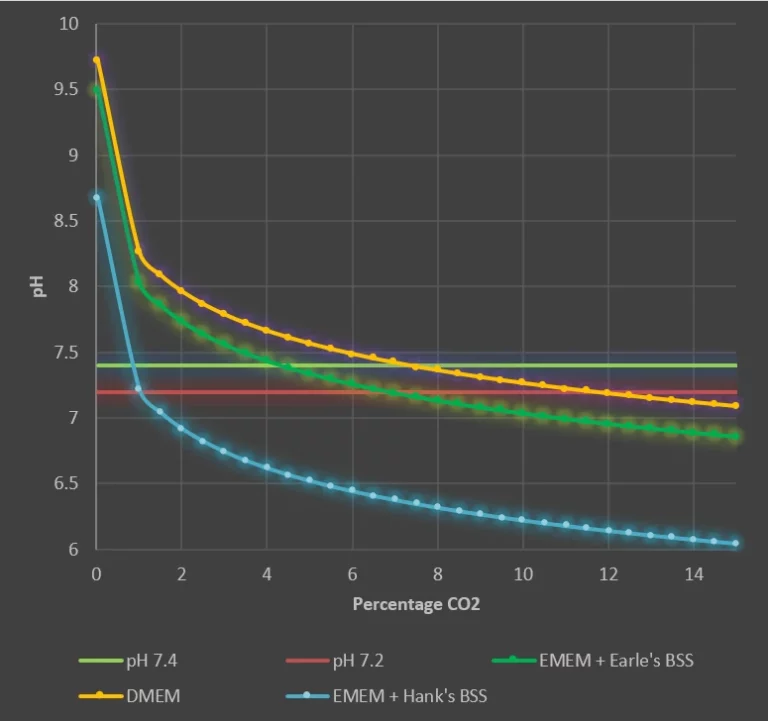
References
Klein, S.G., Alsolami, S.M., Steckbauer, A. et al. A prevalent neglect of environmental control in mammalian cell culture calls for best practices. Nat Biomed Eng 5, 787–792 (2021). https://doi.org/10.1038/s41551-021-00775-0
Michl, J., Park, K. C. & Swietach, P. Evidence-based guidelines for controlling pH in mammalian live-cell culture systems. Commun. Biol. 2019 21 2, 1–12 (2019).
Cooper, J. CO2 concentration and pH control in the cell culture laboratory. Culture Collections, 2019. Accessed on 22nd November 2022.
Lu, C. & Verbridge, S. S. Microfluidic methods for molecular biology. Microfluid. Methods Mol. Biol. 1–376 (2016). doi:10.1007/978-3-319-30019-1
Customize your pack
This pack is highly customizable to fit your experiment specification and cell lines (mammalian, plant, primary…).
You can request additional pumping channels for the flow controller and flow rate sensors. Bubbles can be a problem for cells; the pack can contain a bubble remover to tackle this issue efficiently.
You can contact our experts to answer any questions about this pH control in the cell culture pack and how it can match your specifications.
Frequently asked questions
How can we help your experiment?
This pack is in beta testing phase. So, although the instruments are not fully industrialized, we can provide extensive support as part of our beta testing program. Get in touch to see if you are eligible.
Can a pack be customized?
Yes! Our experts will establish which instruments are best suited for your application, such as the type of flow sensor or the number of flow controller channels you need to perform your experiment. Contact us using the “talk to our experts” green button above.
Can I buy individual instruments?
Our instruments are in beta testing phase and can be tested as a pack or individually, so get in contact with our team to know how our beta testing program works.






